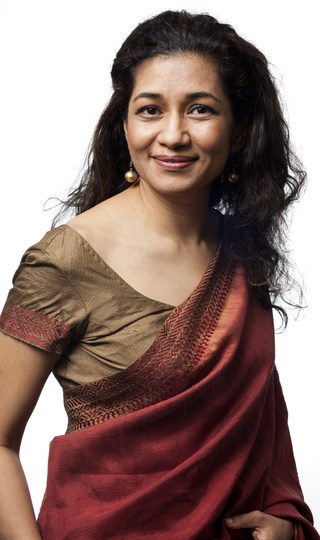Fewer ‘Heropreneurs,’ More Heroic Women: Grameen Foundation’s New CEO Discusses Her Vision for the Organization – And the Broader Financial Inclusion Sector
My recent announcement that I had assumed the role of CEO at Grameen Foundation was often met with two reactions. They went something like this: “Wow, is Muhammed Yunus your hero, too?” and “Oh, Grameen Foundation — they do microfinance, right?”
These reactions highlighted some common misconceptions about Yunus, Grameen Foundation and anti-poverty work in general. So allow me to set the record straight. First, I am a big admirer of Muhammad Yunus’ philosophy of social business as a tool to end poverty. I do not, however, believe his motivation was to become a hero — and I think he would agree that the tendency to elevate business leaders to hero status is something the social business sector should avoid. And second, though the work we do aligns with Yunus’ original inspiration for Grameen Bank, Grameen Foundation focuses on financial inclusion to achieve our mission: to empower people, especially women, to create a world without poverty and hunger. We are not a microfinance institution (MFI).
Exploring these misconceptions can highlight the actual vision behind the microfinance model and Grameen Foundation’s mission, revealing some important truths about social business and anti-poverty work more broadly.
The Problem with Heropreneurship
Muhammad Yunus has been called the “Father of Microfinance. When, in 1976, he launched a project that ultimately became Grameen Bank, “the bank for the poor,” he became a social entrepreneur — long before that descriptor was widely used. But unlike many of today’s social entrepreneurs, Yunus did not set out to elevate his career by starting a social business to solve a problem in someone else’s backyard.
As an economics professor in Bangladesh, he often encountered poor craftswomen on the streets — including a young woman weaving bamboo stools. As he later told the Los Angeles Times, “I couldn’t understand how she could be so poor when she was making such beautiful things.” In getting to know this woman and the barriers she faced, Yunus came to see the inability of craftswomen like her to get credit to supply their trade and turn a profit as the sign of a broken system that perpetuated poverty. His efforts to address that issue would lay the foundation for Grameen Bank’s work and provide an early and prominent example of the concept of social business.
Yunus’ approach stands in contrast to the current age of “heropreneurship.” The heropreneurship model celebrates as the ultimate success the charismatic startup founder who identifies a social problem he or she may (or may not) have lived, then launches a social business to fix it. Though this type of entrepreneur has become commonplace in the social business sector he helped establish, Yunus did not see himself as the superhero swooping in with the solution to poor women’s challenges. He saw the poor women themselves as the heroes, and investing in them as the answer.
This was the essence of Yunus’ vision — a vision that inspired the creation of Grameen Foundation in 1997 and that led me to the organization today. Over the years, as an entrepreneur, a sometimes-reluctant leader and a public speaker, I have spoken to many people, in person and through my TED talk. I always remind my audiences that poor women are not poor of mind. Just like us, female entrepreneurs in developing countries have ideas and drive. Working against all odds and at great personal cost, their efforts are, indeed, heroic. What they lack is the same inclusion, infrastructure and agency afforded to men, particularly those living in more affluent countries. Poor women are not broken; the system is.
How Financial Inclusion Fights Poverty and Empowers Women
Taking on this broken system is what Grameen Foundation does. As with many financial inclusion-focused NGOs, our organization was originally founded to scale microfinance. As Dean Karlan, Chief Economist at USAID and founder of Innovations for Poverty Action explains, in its early days, microfinance was not financially sustainable; it required the support of donors, and NGOs played a central role. However, as the industry matured, a few pioneering for-profit MFIs moved into the space, demonstrating their financial viability and opening the door to the commercialization of the industry. The results were impressive: According to Research and Markets, the global market for microfinance was estimated at US $156.7 billion in 2020, and is projected to grow to US $304.3 billion by 2026.
This evolution created a new place for NGOs like Grameen Foundation in the financial inclusion arena. As Karlan states, NGOs now had three important roles to play: “reaching populations that for-profit institutions have little or no incentive to target; building trust between those institutions and the populations they serve; and promoting innovation.” Today, Grameen Foundation does all those things, with a focus on extending financial inclusion — via agents delivering digital services to last-mile communities, partnerships with pro-poor MFIs, financial and business literacy training, and more — to people that banks consider unprofitable. These are the people Karlan described as “the too rural, the too poor, and the too young,” as well as the elderly and disabled.
Financial inclusion is widely considered to be a key enabler of poverty reduction and a way for the poor to build financial security and prosperity. Yet, according to The World Bank’s Findex survey, 1.4 billion adults still lack access to formal financial services that can open the door to greater savings, access to capital, higher incomes and better lives. Making matters worse, over half of the unbanked are women, generally living in poor households — and even those women who obtain a microloan may not have access to savings, digital payment methods and insurance options.
Here’s what that means in the life of a poor woman. Without a safe place to keep her earnings, she is vulnerable to being separated from her money by male relatives or thieves. Without her own bank account, benefits owed to her by a government welfare program may be paid instead to a male head of her household. Without digital payment methods, she has no affordable way to send money to distant relatives, cannot make or accept payments as an entrepreneur, and cannot build a credit history. Most importantly, she lacks decision-making authority in household finances.
Here’s what that means to the world. As Leora Klapper, a lead economist at The World Bank explains, research shows that when a woman gets an account, she builds savings, spends more on her children’s education and invests in business opportunities. Yunus himself understood that dynamic, writing over two decades ago that “when a destitute woman starts earning income, her dreams of success invariably center around her children. A woman’s second priority is the household. A man … focuses more attention on himself. Thus, money entering the household through a woman brings more benefits to the family as a whole.”
In short, when the world fully opens the doors to financial inclusion for women, we invite the true superheroes to fly in and pull their families out of poverty.
Granted, financial inclusion alone won’t do the job — it is one piece of a puzzle that can only be solved holistically. That’s why Grameen Foundation works with governments, institutions, NGOs and many local partners to tackle discriminatory laws, social norms, and practices that restrict women’s access to opportunity and security. We see the truth in what Atul Gawande wrote in his book about the medical industry, “Better: A Surgeon’s Notes on Performance”: “Better is possible. It does not take genius. It takes diligence. It takes moral clarity. It takes ingenuity. And above all it takes a willingness to try.”
Since arriving at Grameen Foundation, I am frequently asked about my vision for the organization. I am an engineer and entrepreneur. It is in my DNA to believe that we can do better — whether we work in financial inclusion, other social business sectors or the development sector more broadly. When we creatively and systemically deploy social businesses, innovative strategies and technology to provide access to the resources women and girls tell us they need to live sustainable lives, we will end extreme poverty in this world.
So, what is my vision for Grameen Foundation? To push, pull, pry or kick open any door that blocks a heroic woman from leveraging her own potential to rise from poverty — and never slide back.
Zubaida Bai is president and CEO of Grameen Foundation.
Photo courtesy of Grameen Foundation.
- Categories
- Finance, Social Enterprise



